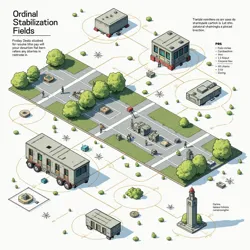The Hilbert's Hotel Incident
The Hilbert's Hotel Incident of 1974 stands as one of the most notorious mathematical containment breaches in recent history, resulting in the temporary disappearance of the entire Heidelberg Mathematical Conference Center and its 257 occupants. The event marked a turning point in the understanding of how abstract mathematical concepts can manifest dangerous physical effects when improperly contained, leading to the establishment of numerous safety protocols that remain in effect today.
 The dimensional void left behind after the Heidelberg Conference Center's disappearance during the Hilbert's Hotel Incident
The dimensional void left behind after the Heidelberg Conference Center's disappearance during the Hilbert's Hotel IncidentThe Initial Experiment
The incident began during the International Conference on Infinite Set Theory, where Dr. Helena Friedmann and her team from the Institute for Mathematical Prophylaxis attempted to demonstrate a practical implementation of Hilbert's infinite hotel paradox. Their goal was to create a controlled spatial manipulation that would allow a finite space to accommodate an infinite number of occupants through careful application of transfinite mathematics.
The experiment initially appeared successful, with conference attendees reporting a strange but manageable sensation of spatial expansion within the building's main lecture hall. However, complications arose when Dr. Friedmann attempted to implement the "shifting rooms" protocol, designed to create space for new guests by moving all existing occupants to rooms numbered n+1.
The Collapse
At approximately 3:47 PM on October 12, 1974, multiple witnesses reported seeing the conference center begin to "fold in on itself" in impossible ways. The building's physical structure started exhibiting properties consistent with infinite set theory, attempting to reconcile the mathematical concept of actual infinity with finite physical space. This reconciliation attempt triggered what would later be termed a Spatial Logic Cascade, causing the entire facility and all occupants to phase partially out of our dimension.
The Bureau of Mathematical Containment response team arrived within minutes but found themselves unable to establish a stable reality anchor due to the severe warping of local space-time geometry. The situation was further complicated by the emergence of several Grothendieck Entities that appeared to have been drawn to the site by the intense mathematical activity.
The Recovery Operation
The rescue operation that followed would become a template for future mathematical containment procedures. Teams equipped with prototype Gödel Suits worked alongside members of the Order of Logical Containment to establish a perimeter of stable axioms around the site. The breakthrough came when Dr. Elisabeth von Neumann proposed using Ordinal Stabilization Fields to gradually reduce the infinite spatial dimensions back to normal physical parameters.
Over the course of seventy-two hours, rescue teams managed to recover all 257 conference attendees, though many exhibited symptoms of severe Categorical Vertigo and temporal displacement. Most notably, several participants remained convinced they had spent centuries in what they described as "Room ω," requiring extensive psychological treatment and reality reorientation.
 Schematic showing the deployment of Ordinal Stabilization Fields during the recovery operation
Schematic showing the deployment of Ordinal Stabilization Fields during the recovery operationAftermath and Investigation
The subsequent investigation by the Global Mathematics Safety Council revealed several critical failures in containment protocols. The conference organizers had failed to properly shield the building's foundation with standard reality anchors, and the experimental protocol lacked adequate safeguards against infinite recursive loops in the spatial manipulation algorithms.
Perhaps most significantly, the investigation uncovered evidence that the incident had been exacerbated by lingering mathematical instabilities from the recent Axiom Wars. The conference center's location near a known proof-phantom territory had created a dangerous resonance that amplified the effects of the failed experiment.
Long-Term Effects
The site of the Hilbert's Hotel Incident remains under constant monitoring due to persistent mathematical anomalies. Researchers from the Center for Transfinite Studies have documented numerous cases of localized infinite regression, and visitors occasionally report experiencing temporal duplications and non-standard cardinality effects.
The incident led directly to the establishment of the Bureau of Spatial Mathematics, a specialized division dedicated to preventing similar breaches of dimensional stability. Their work has been instrumental in developing current safety standards for experiments involving infinite sets and spatial manipulation.
Modern Safety Implications
Today, the Hilbert's Hotel Incident serves as a cornerstone case study at the Academy of Safe Mathematics, where students learn about the dangers of implementing abstract mathematical concepts without proper containment procedures. The incident has also influenced the development of modern Mathematical Quarantine Protocol standards, particularly those dealing with the physical manifestation of infinite sets.
The Department of Preemptive Mathematics continues to study data from the incident, working to better understand the mechanisms by which mathematical abstractions can affect physical reality. Their research has led to significant improvements in containment technology, including the development of more effective reality anchors and new techniques for managing mathematical field interactions.
See Also
- Cambridge Collapse
- Topos Syndrome
- Metamathematical Consciousness Institute
References
- "The Hilbert Paradox: From Theory to Catastrophe" - Journal of Mathematical Containment Studies
- "Infinite Sets in Finite Spaces: A Technical Analysis of the Heidelberg Incident" - Bureau of Mathematical Containment
- "Reality Anchor Deployment in Mathematical Emergency Response" - Department of Preemptive Mathematics